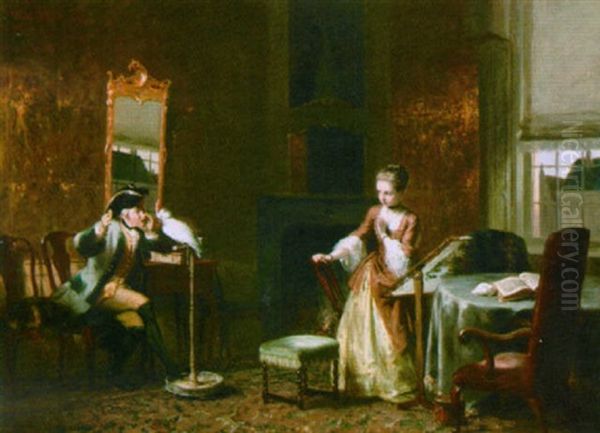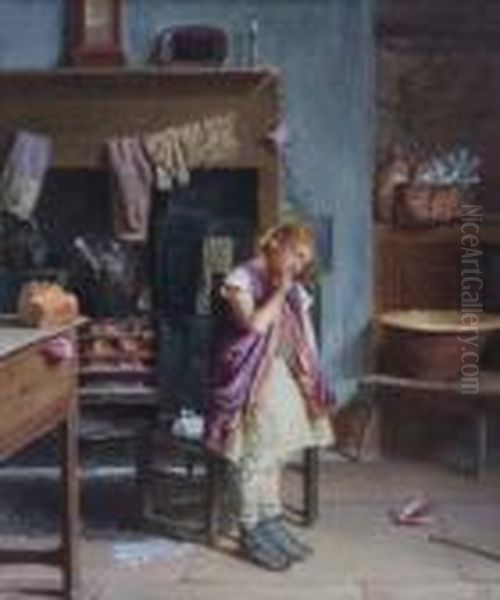David Joseph Bles (1821-1899) stands as a significant figure in 19th-century Dutch art, celebrated for his charming and often humorous genre scenes. Born in The Hague (Den Haag), Netherlands, on September 19, 1821, Bles carved a distinct niche for himself by primarily depicting anecdotal and satirical episodes set in the 18th century, a period not widely favored by his contemporaries. His work is characterized by a keen observation of human nature, a delightful sense of wit, and a meticulous attention to detail, particularly in costume and interior settings.
Early Life and Artistic Formation
David Bles's artistic journey began in his hometown, The Hague, a city with a rich artistic heritage. He initially enrolled at the prestigious Hague Academy of Art (Haagsche Teeken-Academie) around 1838, where he studied under the tutelage of Cornelis Kruseman (1797-1857). Kruseman, a respected painter known for his historical scenes and portraits, would have provided Bles with a solid foundation in academic drawing and painting techniques. This early training instilled in Bles a discipline and an appreciation for craftsmanship that would underpin his entire career.
Seeking to broaden his artistic horizons, Bles, like many aspiring artists of his time, traveled to Paris between 1841 and 1843. The French capital was then the undisputed center of the European art world, buzzing with new ideas and artistic movements. In Paris, he further honed his skills, reportedly studying with Joseph-Nicolas Robert-Fleury (1797-1890), a prominent French historical and genre painter. Robert-Fleury's influence likely encouraged Bles's inclination towards narrative painting and the depiction of historical settings, although Bles would eventually develop a lighter, more humorous touch than his French mentor. His time in Paris was crucial for refining his ability to capture nuanced human interactions and detailed environments.
The Signature Style: Humour, Satire, and the 18th Century

Upon his return to the Netherlands, Bles established himself as a painter of genre scenes, but with a particular twist. He specialized in compositions set in the preceding century, the 18th century, often referred to as the "periwig period" (pruikentijd) in Dutch. This choice was somewhat unconventional, as many 19th-century Dutch artists were either looking back to the Golden Age of the 17th century or embracing contemporary realism and Impressionistic trends. Bles, however, found fertile ground in the Rococo aesthetics and social manners of the 18th century for his witty observations.
His paintings are typically small to medium in scale, inviting intimate viewing. They often feature characters in elaborate 18th-century attire – powdered wigs, silk coats, elegant dresses – engaged in everyday activities, amorous encounters, domestic squabbles, or moments of gentle folly. Bles possessed a remarkable talent for storytelling, conveying narratives through gestures, facial expressions, and carefully chosen props. His humor is rarely biting or cruel; instead, it's an "optimistic unmasking of human foibles," as one source described, gently poking fun at vanity, courtship rituals, minor embarrassments, and the charming absurdities of social life.
The artist's meticulous rendering of costumes, furniture, and interior details not only adds to the historical authenticity of his scenes but also enhances their visual appeal. He was a master of depicting textures – the sheen of silk, the softness of velvet, the gleam of polished wood. This attention to detail, combined with his lively characterizations, made his works highly popular with the bourgeois collectors of his time, who appreciated both the technical skill and the amusing subject matter.
Influences and Artistic Context
David Bles's art did not emerge in a vacuum. His style shows an awareness of earlier masters of genre and satire. He is often said to have been influenced by the Flemish painter David Teniers the Younger (1610-1690), known for his lively peasant scenes and tavern interiors, and the Scottish painter Sir David Wilkie (1785-1841), who excelled in anecdotal genre paintings with a strong narrative component. The spirit of English satirist William Hogarth (1697-1764) can also be felt in Bles's work, particularly in the way he used art to comment on social manners, though Bles's satire was generally gentler and less moralizing than Hogarth's.

Within the Dutch tradition itself, Bles can be seen as an heir to painters like Jan Steen (c. 1626-1679), whose bustling, humorous depictions of everyday life in the 17th century set a precedent for genre painting with a comic edge. While Steen's humor was often broader and more boisterous, Bles adapted this tradition to the more refined, albeit still humorous, sensibilities of the 18th-century settings he favored. He also shared some thematic similarities with Cornelis Troost (1696-1750), an earlier Dutch painter who specialized in Rococo genre scenes and theatrical subjects. However, critics often noted that Troost's humor could be more sophisticated or pointed, while Bles aimed for a more universally accessible charm.
Interestingly, Bles was the grandson of Herri met de Bles (c. 1510 – c. 1555–1560), a Flemish Northern Renaissance landscape painter. While their styles and subject matter were vastly different, this lineage places David Bles within a long family tradition of artistic pursuit. In the 19th-century Dutch art scene, Bles stood somewhat apart from the dominant Hague School painters like Jozef Israëls, Anton Mauve, or Hendrik Willem Mesdag, who were known for their atmospheric landscapes and depictions of peasant and fishing life in a more somber, realistic vein. Bles's focus on historical genre with a lighthearted touch offered a distinct alternative.
Notable Works and Thematic Concerns
Several paintings exemplify David Bles's characteristic style and thematic preoccupations. While a comprehensive catalogue raisonné is beyond this scope, key works often cited include:
The Music Lesson: This title, popular among many artists including Johannes Vermeer, was also tackled by Bles. In his rendition, one can expect a scene rich in 18th-century costume, likely involving a young lady at a harpsichord or other instrument, perhaps with a male admirer or a slightly exasperated music master. Such scenes allowed Bles to explore themes of courtship, social accomplishment, and subtle human interactions, all within an elegantly appointed interior.
Spilt Milk: This work, likely a watercolor given one reference, suggests a domestic mishap. The title itself evokes a sense of minor catastrophe and the ensuing reactions – perhaps embarrassment, annoyance, or a comical attempt to rectify the situation. Bles would have excelled at capturing the varied expressions of the figures involved, turning a simple accident into an amusing vignette.
Portrait of a Young Man: While primarily known for his genre scenes, Bles also undertook portraiture. A work like Portrait of a Young Man would demonstrate his skill in capturing a likeness, though likely still imbued with a certain charm and attention to the sitter's attire and personality, consistent with his overall artistic approach.

The Composer (Le Compositeur): This painting, possibly on a mahogany panel, would depict an 18th-century composer at work, perhaps surrounded by musical scores and instruments. It offers an opportunity for Bles to portray intellectual pursuit within a period setting, potentially with a touch of humor related to the frustrations or inspirations of the creative process.
The Handsome Shopkeeper's Daughter (or similar titles like The Shop Girl): This theme allowed Bles to explore social dynamics and subtle flirtations in a commercial setting. One description mentions a shopkeeper more interested in his daughter than in selling his wares, highlighting Bles's ability to create humorous narratives around everyday human weaknesses and attractions. Such works were popular for their gentle satire and relatable scenarios.
His oeuvre consistently features scenes of courtship, domestic life, professional settings (like a doctor's visit or a lawyer's office), and leisurely pursuits, all filtered through the lens of 18th-century aesthetics and his own witty perspective. The use of dramatic costumes, hats, and props was not merely for historical accuracy but also served as a tool to enhance the theatricality and humor of his compositions.
Recognition, Exhibitions, and Legacy
David Bles achieved considerable success and recognition during his lifetime. His paintings were popular not only in the Netherlands but also abroad, finding their way into numerous private and public collections. A significant honor was bestowed upon him in 1863 when he was made a Knight of the Order of Leopold by the Belgian King, a testament to his international reputation.
His works were regularly exhibited at the "Exhibitions of Living Masters" (Tentoonstelling van Levende Meesters) in cities like Amsterdam, The Hague, and Rotterdam. Posthumously, his paintings have continued to appear in auctions at major houses such as Christie's and Sotheby's, indicating a sustained interest among collectors. For instance, The Music Lesson was noted as part of the Dr. Jacob Hartog estate and auctioned at Christie's. Portrait of a Young Man was auctioned at Sotheby's in Amsterdam. A watercolor, Spilt Milk, appeared at Parker Fine Art Auctions, and Le Compositeur was handled by Veilinghuis Bernaerts, with authentication from the G. F. Ferbach gallery. A painting titled Bergerie (pastoral scene) was reportedly donated to the Peace Palace in The Hague for decoration.
While specific exhibition dates from the provided text sometimes seem to refer to modern shows or works by other artists with similar titles (e.g., a 2013 Brussels exhibition of "The Music Lesson" or various recent showings of "Portrait of a Young Man" which could be by other artists like Andrea del Sarto), the core fact remains that Bles's works were, and continue to be, part of the art market and collections.
David Bles's legacy lies in his skillful and charming revival of genre painting with a historical focus. He successfully carved out a unique artistic identity by concentrating on the 18th century, an era often viewed critically in 19th-century Netherlands as one of moral and societal decline. Bles, however, approached it not with condemnation but with an amused eye, finding in its customs and costumes a rich source for his art. He offered his audience a delightful escape into a bygone era, filled with elegance, humor, and relatable human stories.
His ability to combine technical proficiency with accessible and entertaining subject matter ensured his popularity. He can be compared to other 19th-century European genre painters who specialized in historical scenes, such as the French artists Jean-Louis-Ernest Meissonier (1815-1891), known for his meticulous historical detail, or Jehan Georges Vibert (1840-1902), who often painted humorous scenes involving cardinals. While Bles's scope might have been more modest, his contribution to Dutch art is undeniable. He kept alive a tradition of narrative genre painting that provided a counterpoint to the more dominant trends of landscape and realism in his time. Other Dutch artists who explored genre or historical themes in the 19th century, though perhaps with different approaches, include figures like Charles Rochussen (1814-1894) or history painters like Nicolaas Pieneman (1809-1860). Bles's particular blend of humor and 18th-century nostalgia, however, remained distinctly his own.
Conclusion
David Joseph Bles passed away in The Hague on October 3, 1899, leaving behind a substantial body of work that continues to charm viewers. As an art historian, I see him as a master of his chosen niche, a painter who understood the enduring appeal of well-told stories, gentle humor, and meticulous craftsmanship. He skillfully navigated the artistic currents of his time, drawing on historical traditions while creating a style that was uniquely his own. His paintings offer a window into an imagined 18th century, filtered through a 19th-century sensibility, and remain a delightful testament to his talent for capturing the lighter side of human existence. His works are held in various Dutch museums, including the Rijksmuseum in Amsterdam and the Kunstmuseum Den Haag, as well as in numerous private collections worldwide, ensuring that his witty observations and elegant portrayals continue to be appreciated.